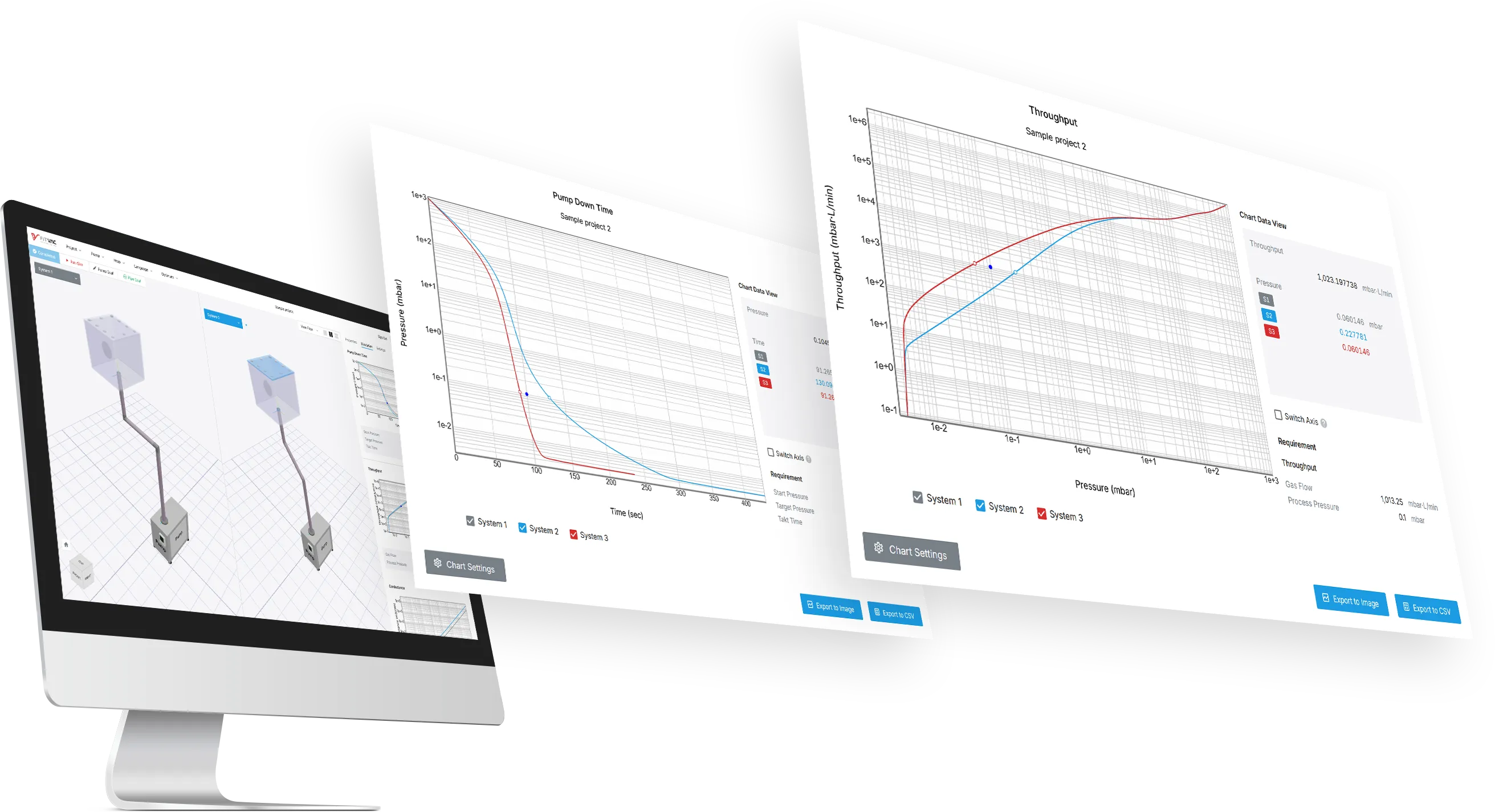Calculator
Step 1: Vacuum Requirement at Chamber
There are values not entered.
Step 2: Vacuum Pump Data Input
- Modify the pumping speed data of the pump to be used.
There are values not entered.
Step 3: Vacuum throughput result
under gas flow:
? Pa
- Green: Requirement satisfied
- Red: Requirement not satisfied
- Black: Not comparable
| Green | Red | Black |
|---|---|---|
| Requirement satisfied | Requirement not satisfied | Not comparable |
Vacuum
System
Vacuum
Pump
Throughput
Vacuum
System
Vacuum
Pump
Throughput
Vacuum
System
Vacuum
Pump
Throughput
- Please note that it is calculation for very simple vacuum system without piping. With piping, the process pressure will be much higher than the simulation result.
For a more accurate simulation of vacuum systems with complex piping,
Try Our Solution for Free!
Start a Free TrialGas Flow Status
- Viscous flow: Known as continuous flow, frequent collisions between gas molecules occur much more than collisions with the walls of pipe. Mean free path of a gas molecule is significantly shorter than the inner diameter of pipe.
- Transition flow: Known as knudsen flow, mean free path of a gas molecule is roughly equal to the inner diameter of pipe. This flow happens in between viscous flow and molecular flow.
- Molecular flow: Mean free path of a gas molecule is significantly greater than the inner diameter of pipe.


Conductance: C
There is the physical effect of pipe, fittings, valves in the vacuum system. All these components connected between chamber and pump are resistance to gas flow and will reduce the pumping speed of pump ($S$).
- Conductance of circular straight pipe for air at 20 ℃:

Viscous flow: $C_{v} = 135 (D^{4} / L)\times P_{ave}$ (L/sec)
Transition flow: $C_{t} = 135 (D^{4} / L)\times P_{ave} + 12.1 D^{3}/L$ (L/sec)
Molecular flow: $C_{m} = 12.1 D^{3} / L$ (L/sec)
$C_{v}$: Conductance of pipe in viscous flow
$C_{t}$: Conductance of pipe in transition flow in between viscous and molecular (L/sec)
$C_{m}$: Conductance of pipe in molecular flow
$D$: Pipe inner diameter (cm)
$P_{ave}$: Average pressure in pipe
$L$: Length of pipe (cm)
Pumping Speed of Pump: S
A pump name usually uses the peak pumping speed, so it can be misunderstood as having this value in all pressure ranges. But the pumping speed of pump is not a constant value.
For example, as shown below, if there is a pump named FV300, this pump has a peak pumping speed of 300 m³/hr only at ATM and does not have a value of 300 m³/hr in all pressure ranges.
Please keep in mind that the pumping speed is not a constant value, but a variable value depending on the pressure.

Effective Pumping Speed at Chamber: Seff
By the flow resistance in a pipe, the effective pumping speed working at chamber ($S_{eff}$) is always less than the pumping speed of pump ($S$).
$1/S_{eff}=1/S+1/C$
$S_{eff}=(S·C)/(S+C)$
$S_{eff}$: Effective pumping speed at chamber
$S$: Pumping speed of pump
$C$: Total conductance of pipe
$C$ is the total conductance of piping in the vacuum system consisted of various components such as pipes, fittings, valves.
- In serial connection, the total conductance $C$ is:
$1/C=1/C_{1}+1/C_{2}+1/C_{3}+\ldots+1/C_{N}$
- In parallel connection, the total conductance $C$ is:
$C=C_{1}+C_{2}+C_{3}+C_{4}+\ldots+C_{N}$
Vacuum Throughput (Flow/Pressure) Calculation
The chamber pressure estmation according to the gas flow rate is one of the important tasks in configuring and designing a vacuum system. Through the throughput simulation of the configured system, it can be estimated whether the chamber pressure is maintained lower than the desired pressure. Gas is based on N2 at room temp.
Formula
It is used the equation below to calculate throughput (flow/pressure):
$Q=P·S_{eff}$
$Q$: Throughput
$S_{eff}$: Effective pumping speed at chamber
$P$: Pressure
Note: The effective pumping speed at chamber ($S_{eff}$) is actual pumping speed working at chamber combined with pumping speed of pump ($S$) and total conductance of pipe ($C$).
Vacuum Throughput (Flow/Pressure) Manual Calculation
without Pipe Conductance
- Pump: FV300
- Requirement: maintain ≤ 50 mbar chamber pressure under 50 slm gas flow
Pumping speed curve


Calculation with Pumping Speed
$Q=P·S_{eff}$
$Q1=(1.0E+03)\times(3.0E+02)=3.0E+05\ \mathrm{mbar}·\mathrm{m^{3}/hr}=4.9E+03\ \mathrm{slm}$
$Q2=(6.0E+01)\times(2.3E+02)=1.4E+04\ \mathrm{mbar}·\mathrm{m^{3}/hr}=2.3E+02\ \mathrm{slm}$
$Q3=(2.0E+00)\times(1.5E+02)=3.0E+02\ \mathrm{mbar}·\mathrm{m^{3}/hr}=4.9E+00\ \mathrm{slm}$
$Q5=(2.0E-01)\times(8.0E+01)=1.6E+01\ \mathrm{mbar}·\mathrm{m^{3}/hr}=2.6E-01\ \mathrm{slm}$
$Q5=(8.0E-02)\times(4.0E+01)=3.2E+00\ \mathrm{mbar}·\mathrm{m^{3}/hr}=5.3E-02\ \mathrm{slm}$
$Q6=(5.2E-02)\times(1.0E+01)=5.2E-01\ \mathrm{mbar}·\mathrm{m^{3}/hr}=8.6E-03\ \mathrm{slm}$
$Q7=(5.0E-02)\times(1.0E+00)=5.0E-02\ \mathrm{mbar}·\mathrm{m^{3}/hr}=8.2E-04\ \mathrm{slm}$


- Requirement: maintain ≤ 50 mbar chamber pressure under 50 slm gas flow
- With FV300, the estimated chamber pressure under 50 slm gas flow will be 15 mbar. So it meets the requirement. By the valve opening control, 50 mbar at chamber under 50 slm gas flow can be achievable.
- Direct connection between chamber and pump without pipe connection, $S_{eff}=S$
Vacuum Throughput (Flow/Pressure) Manual Calculation
with Pipe Conductance
- Pump: FV300
- Pipe: 500 m³/hr (constant conductance*)
- Requirement: maintain ≤ 50 mbar chamber pressure under 50 slm gas flow
Effective pumping speed


$S_{eff}=(S·C)/(S+C)$
$S_{eff}@1.0E+03\ \mathrm{mbar}=188\ \mathrm{m^{3}/hr}$
$S_{eff}@6.0E+01\ \mathrm{mbar}=158\ \mathrm{m^{3}/hr}$
$S_{eff}@2.0E+00\ \mathrm{mbar}=115\ \mathrm{m^{3}/hr}$
$S_{eff}@2.0E-01\ \mathrm{mbar}=69\ \mathrm{m^{3}/hr}$
$S_{eff}@8.0E-02\ \mathrm{mbar}=37\ \mathrm{m^{3}/hr}$
$S_{eff}@5.2E-02\ \mathrm{mbar}=9.8\ \mathrm{m^{3}/hr}$
$S_{eff}@5.2E-02\ \mathrm{mbar}=0.99\ \mathrm{m^{3}/hr}$
Throughput Calculation with Effective Pumping Speed
$Q=P·S_{eff}$
$Q1=(1.0E+03)\times(1.88E+02)=1.9E+05\ \mathrm{mbar}·\mathrm{m^{3}/hr}=3.1E+03\ \mathrm{slm}$
$Q2=(6.0E+01)\times(1.58E+02)=9.5E+04\ \mathrm{mbar}·\mathrm{m^{3}/hr}=1.6E+02\ \mathrm{slm}$
$Q3=(2.0E+00)\times(1.15E+02)=2.3E+02\ \mathrm{mbar}·\mathrm{m^{3}/hr}=3.8E+00\ \mathrm{slm}$
$Q4=(2.0E-01)\times(6.90E+01)=1.4E+01\ \mathrm{mbar}·\mathrm{m^{3}/hr}=2.3E-01\ \mathrm{slm}$
$Q5=(8.0E-02)\times(3.70E+01)=3.0E+00\ \mathrm{mbar}·\mathrm{m^{3}/hr}=4.9E-02\ \mathrm{slm}$
$Q6=(5.2E-02)\times(9.8E+00)=5.1E-01\ \mathrm{mbar}·\mathrm{m^{3}/hr}=8.4E-03\ \mathrm{slm}$
$Q7=(5.0E-02)\times(9.9E-01)=5.0E-02\ \mathrm{mbar}·\mathrm{m^{3}/hr}=8.2E-04\ \mathrm{slm}$


- Requirement: maintain ≤ 50 mbar chamber pressure under 50 slm gas flow
- With FV300 and 500 m³/hr pipe, the estimated chamber pressure under 50 slm gas flow will be 20 mbar. So it meets the requirement. By the valve opening control, 50 mbar at chamber under 50 slm gas flow can be achievable.
- The pipe conductance, 500 m³/hr is considered as a constant value in all pressure range. So the pump throughput calculation in this way is much closer than the previous way but still gap from the reality.
- Conductance of pipes are variable values depend on pressure with normally 3 different gas flow status. $C_{v}$, $C_{t}$, $C_{m}$ should be considered for more accurate calculation of pipe conductance.
